Here are the stories for today...
Of note, from the "it's not always about airplanes" category, a story from Milan, Italy where a guy started a ticket counter on fire at Milan Malpensa Airport...
Be safe out there!
Tom
Chaos at Milan Malpensa Airport after passenger ‘set fire to check-in desk’
Travellers were seen outside the building as emergency crews worked to battle the flames, which filled the terminal with thick smoke
Steffie Banatvala
A major European airport has been forced to close off parts of its terminal after a fire broke out at a check-in desk.
off parts of its terminal after a fire broke out at a check-in desk.
Part of Milan Malpensa Airport’s Terminal One was closed after a man reportedly set fire to the check-in area, according to the Lombardy Airports Association.
Travellers were seen queuing outside the building as emergency crews worked to battle the flames, which filled the terminal with thick smoke.
Footage shared on social media appears to show the man being challenged by several people and then pinned to the ground by staff. Cries of alarm can also be heard.
After first setting fire to a waste bin, the man damaged check-in desks and information screens with a hammer, Varese News reported.
The fire was started using a flammable liquid around 11am local time. A SEA employee noticed the rising smoke and intervened while the suspect was destroying screens between desks 12 and 13, Varese News added.
Border Police officers soon arrived and restrained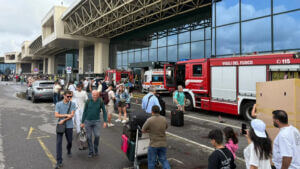 the man, while staff from airport security company ICTS worked to put out the flames.
the man, while staff from airport security company ICTS worked to put out the flames.
The SEA employee who intervened was injured and treated by emergency medical services but no other injuries have yet been reported.
The hammer was taken by Polaria officers, who are now investigating the incident and the attacker’s motives.
“The situation was quickly brought under control after the arrest of the madman who set fire to and destroyed several check-in desks,” The Lombardy Airports Association updated, after previously saying that half of the check-in area was closed.
“Due to the closure of some areas and the evacuation of premises, there may be delays and cancellations for departures from Malpensa T1.”
https://www.independent.co.uk/news/world/europe/fire-milan-malpensa-airport-italy-b2810974.html
Boeing Plane Makes Emergency Landing After Flames Seemingly Shoot Out of Engine: ‘An Incredibly Horrible Experience’
Hannah Knudsen
A Boeing plane made an emergency landing in Italy on Saturday after flames were seen shooting out of one of the engines, sending a jolt through passengers, some of whom thought it was the end.
Italy on Saturday after flames were seen shooting out of one of the engines, sending a jolt through passengers, some of whom thought it was the end.
A Condor Airlines flight, originating from Corfu, Greece, en route to Düsseldorf, Germany, reportedly experienced what the New York Post described as “a turbine airflow disruption at an altitude of approximately 36,000 feet.” Passengers reportedly noticed flames shooting out of the right engine of the airplane.
One passenger said the power went out “for a few seconds,” and they realized they were “no longer climbing.” Another passenger, describing it as “an incredibly horrible experience,” sent goodbye texts because they thought “it’s over now.”
However, Flight DE 3665 was able to make a safe emergency landing at Italy’s Brindisi Airport, roughly 40 minutes after its initial departure from Corfu. All 273 passengers and 8 crew members were accounted for and uninjured.
A Condor Airlines spokesperson told People the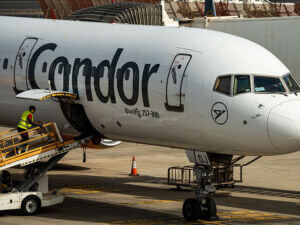 incident was the result of a chemical reaction in the engine’s combustion chamber and that no one was ever in true danger.
incident was the result of a chemical reaction in the engine’s combustion chamber and that no one was ever in true danger.
“Flight DE3665 from Corfu (CFU) to Düsseldorf (DUS) diverted to Brindisi (BDS) on 16 August 2025. The reason was a parameter indication outside the normal range caused by a disturbance in the air flow supply to the engine,” Condor Airlines stated.
It added that “another Condor aircraft was dispatched to carry all guests to Düsseldorf on August 17.”
“We apologize for any inconvenience caused, but the safety of our passengers and employees is always our top priority,” the airline added.
https://www.breitbart.com/europe/2025/08/19/boeing-plane-makes-emergency-landing-after-flames-seemingly-shoot-out-of-engine-an-incredibly-horrible-experience/
Plane Crashes After Unsuccessful Takeoff in Katama
Ethan Genter
A small private airplane landed near the FARM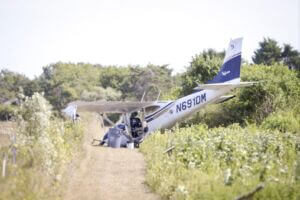 Institute in Katama Tuesday after struggling with its takeoff from the nearby airfield, according to officials.
Institute in Katama Tuesday after struggling with its takeoff from the nearby airfield, according to officials.
Shortly after 3 p.m., first responders were called to the border of the farm after the plane went down, ending up leaning on its nose. The two people aboard the plane had minor injuries but declined to be brought to the hospital, according to Edgartown fire Chief Alex Schaeffer.
The plane was attempting to fly off from the Katama Airfield, the chief said, before landing along the property run by the Trustees of Reservations.
There were no bystanders nearby at the time of the crash and children at the farm’s day camp had already left for the day, according to the Trustees.
Chief Schaeffer said Edgartown and state police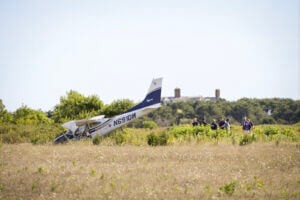 also responded to the crash, and the Federal Aviation Administration was investigating.
also responded to the crash, and the Federal Aviation Administration was investigating.
The FAA confirmed they were looking into the incident but did not have further details Tuesday afternoon.
According to federal records, the 1975 Cessna Skylane belongs to the 43rd Flying Club, a nonprofit aviation group that flies out of Hartford, Conn.
https://vineyardgazette.com/news/2025/08/19/plane-crashes-after-unsuccessful-takeoff-katama
Flight instructor, student pilot hurt in emergency landing Tuesday in Johnson County, Missouri, cornfield
By: Sam Hartle
KANSAS CITY, Mo. — A flight instructor and student pilot suffered minor injuries when their plane's engine failed and they were forced to make an emergency landing in a cornfield in Johnson County, Missouri.
student pilot suffered minor injuries when their plane's engine failed and they were forced to make an emergency landing in a cornfield in Johnson County, Missouri.
A news release from the Johnson County, Missouri, Fire Protection District stated the incident happened around 4:45 p.m. north of Centerview.
Crews found the single-engine plane about 200 yards off NW 501 Road near the Blackwater River, according to the news release.
The flight instructor and student pilot suffered non-life-threatening injuries.
Authorities said the flight came from the Lee's Summit Airport.
The Federal Aviation Administration has been notified about the incident.
https://www.kshb.com/news/crime/aircraft-makes-emergency-landing-in-cornfield-near-centerview-missouri
NTSB Prelim: Piper J5C
About 20 Minutes Into The Flight, The Engine Started To Surge
Location: Rochester, NY Accident Number: ERA25FA283
Date & Time: August 1, 2025, 13:30 Local Registration: N28151
Aircraft: Piper J5C Injuries: 1 Fatal, 1 Serious
Flight Conducted Under: Part 91: General aviation - Personal
On August 1, 2025, about 1330 eastern daylight time, a Piper J5C, NC 28151, was substantially damaged when it was involved in an accident near Rochester, New York. The passenger was fatally injured, and the pilot was seriously injured. The airplane was operated as a Title 14 Code of Federal Regulations Part 91 personal flight.
According to the pilot, the airplane had not flown in several months and he had to remove mud dauber nests from the wings. They took off from a private runway, which was the owner/passenger’s, on the west side of Rochester, New York and flew east for about 30 minutes to Whitfords Airport (B16), Weedsport, New York. They put 6 gallons of fuel in the airplane. The fuel sight gauges in each wing indicated full fuel tanks when they departed. The pilot added that during the return flight home, about 20 minutes into the flight, the engine started to surge. The engine rpm would go from full rpm of about 2,300 rpm to idle. Then seconds later, the engine would return to full power. Each time the engine would surge and go to an idle setting, the pilot would look for a place to land, either a parking lot or street. When the engine would return to full power, the pilot would climb and try to get as much altitude as possible. On the fifth or sixth time the engine surged, it lost all power, and the pilot tried to make a forced landing on a street. During the approach to land, the airplane contacted the top of a tree and then impacted the ground.
The accident site was compact and all major components of the airplane were present. The airplane’s six propeller bolts made 1” impression marks in the blacktop about 10 feet away from the main wreckage. The main wreckage came to rest inverted and oriented on a heading of 235°. The leading edges of both wings were accordion crushed aft down their entire lengths. The fabric was torn on the wings and empennage from impact forces. The empennage was bent upward and forward. The instrument panel was crushed aft. Flight control continuity was established from the cockpit controls to all flight control surfaces. No electrical system was installed in the airplane. The rudder and elevator were intact and unremarkable. The ailerons were installed and intact. The left aileron connecting rod was impact fractured. Both wing fuel tanks were breached. There was no fuel in either tank. The fuel gasolator was removed. Dirt and debris was found at the bottom of the gasolator. Air was blown through the fuel lines and no obstructions were noted. No mud dauber nests were found in the fuel system; however, much of the system, including the vent, was impact damaged.
The wooden propeller was still connected to the engine’s propeller flange. One propeller blade was fractured and splintered. The spinner dome was crushed. The propeller flange was impact damaged and the crankshaft was bent. The magnetos were removed and their input drives were rotated by hand. The left magneto produced spark on all leads. The right magneto was impact damaged and the internal gears were crushed. The right magneto rotated but did not spark. The carburetor was fractured into several pieces from impact with the ground. The propeller was rotated by hand and thumb compression was established on all cylinders. A lighted borescope was used to inspect the inside of all of the engine’s cylinders with no anomalies noted.
FMI: www.ntsb.gov
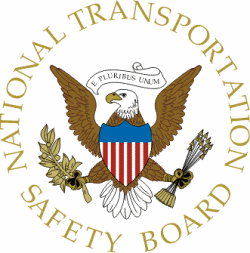
Today in History
17 Years ago today: On 20 August 2008 Spanair flight 5022, an MD-82, crashed following a loss of control on takeoff from Madrid-Barajas Airport, Spain, killing 154 occupants; 18 survived the accident.
| Date: | Wednesday 20 August 2008 |
| Time: | 14:24 |
| Type: | McDonnell Douglas DC-9-82 (MD-82) |
| Owner/operator: | Spanair |
| Registration: | EC-HFP |
| MSN: | 53148/2072 |
| Year of manufacture: | 1993 |
| Engine model: | P&W JT8D-219 |
| Fatalities: | Fatalities: 154 / Occupants: 172 |
| Other fatalities: | 0 |
| Aircraft damage: | Destroyed, written off |
| Category: | Accident |
| Location: | Madrid-Barajas Airport (MAD) - Spain |
| Phase: | Take off |
| Nature: | Passenger - Scheduled |
| Departure airport: | Madrid-Barajas Adolfo Suárez Airport (MAD/LEMD) |
| Destination airport: | Las Palmas-Airport de Gran Canaria (LPA/GCLP) |
| Investigating agency: | CIAIAC |
| Confidence Rating: | Accident investigation report completed and information captured |
Narrative:
Spanair flight 5022, an MD-82, crashed following a loss of control on takeoff from Madrid-Barajas Airport, Spain, killing 154 occupants; 18 survived the accident.
The MD-82 aircraft operated Spanair flight JK5022 from Madrid-Barajas (MAD) to Gran Canaria (LPA). The estimated departure time was 13:00.
The aircraft was authorized by control for engine start-up at 13:06:15. It then taxied to runway 36L from parking stand T21, which it occupied on the apron of terminal T2 at Barajas. The flaps were extended 11°. Once at the runway threshold, the aircraft was cleared for takeoff at 13:24:57. The crew informed the control tower at 13:26:27 that they had a problem and that they had to exit the runway. At 13:33:12, they communicated that they were returning to the stand.
The crew had detected an overheating Ram Air Temperature (RAT) probe. The aircraft returned to the apron, parking on remote stand R11 of the terminal T2 parking area. The crew stopped the engines and requested assistance from maintenance technicians to solve the problem. The mechanic confirmed the malfunction described in the ATLB, checked the RAT probe heating section of the Minimum Equipment List (MEL) and opened the electrical circuit breaker that connected the heating element. Once complete, it was proposed and accepted that the aircraft be dispatched.
The aircraft was topped off with 1080 liters of kerosene and at 14:08:01 it was cleared for engine start-up and to taxi to runway 36L for takeoff.
The crew continued with the tasks to prepare the airplane for the flight. The conversations on the cockpit voice recorder revealed certain expressions corresponding to the before engine start checklists, the normal start list, the after start checklist and the taxi checklist. During the taxi run, the aircraft was in contact with the south sector ground control first and then with the central sector. On the final taxi segment the crew concluded its checks with the takeoff imminent checklist.
At 14:23:14, with the aircraft situated at the head of runway 36L, it was cleared for takeoff. Along with the clearance, the control tower informed the aircraft that the wind was from 210° at 5 knots.
At 14:23:19, the crew released the brakes for takeoff. Engine power had been increased a few seconds earlier and at 14:23:28 its value was 1.4 EPR. Power continued to increase to a maximum value of 1.95 EPR during the aircrafts ground run. The CVR recording shows the crew calling out "V1" at 14:24:06, at which time the DFDR recorded a value of 147 knots for calibrated airspeed (CAS), and "rotate" at 14:24:08, at a recorded CAS of 154 knots. The DFDR recorded the signal change from ground mode to air mode from the nose gear strut ground sensor. The stall warning stick shaker was activated at 14:24:14 and on three occasions the stall horn and synthetic voice sounded in the cockpit: "[horn] stall, [horn] stall, [horn] stall". Impact with the ground took place at 14:24:23.
During the entire takeoff run until the end of the CVR recording, no noises were recorded involving the takeoff warning system (TOWS) advising of an inadequate takeoff configuration. During the entire period from engine start-up while at parking stand R11 to the end of the DFDR recording, the values for the two flap position sensors situated on the wings were 0°.
The length of the takeoff run was approximately 1950 m. Once airborne, the aircraft rose to an altitude of 40 feet above the ground before it descended and impacted the ground. During its trajectory in the air, the aircraft took on a slight left roll attitude, followed by a fast 20° roll to the right, another slight roll to the left and another abrupt roll to the right of 32°. The maximum pitch angle recorded during this process was 18°.
The aircrafts tailcone was the first part to impact the ground, almost simultaneously with the right wing tip and the right engine cowlings. The marks from these impacts were found on the right side of the runway strip as seen from the direction of the takeoff, at a distance of 60 m, measured perpendicular to the runway centerline, and 3207.5 m away from the threshold, measured in the direction of the runway. The aircraft then traveled across the ground an additional 448 m until it reached the side of the runway strip, tracing out an almost linear path at a 16° angle with the runway. It lost contact with the ground after reaching an embankment/drop-off beyond the strip, with the marks resuming 150 m away, on the airport perimeter road, whose elevation is 5.50 m lower than the runway strip. The aircraft continued moving along this irregular terrain until it reached the bed of the Vega stream, by which point the main structure was already in an advanced state of disintegration. It is here that it caught on fire. The distance from the initial impact site on the ground to the farthest point where the wreckage was found was 1093 m.
CAUSES:
The crew lost control of the airplane as a consequence of entering a stall immediately after takeoff due to an improper airplane configuration involving the non-deployment of the slats/flaps following a series of mistakes and omissions, along with the absence of the improper takeoff configuration warning.
The crew did not identify the stall warnings and did not correct said situation after takeoff. They momentarily retarded the engine throttles, increased the pitch angle and did not correct the bank angle, leading to a deterioration of the stall condition.
The crew did not detect the configuration error because they did not properly use the checklists, which contain items to select and verify the position of the flaps/slats, when preparing the flight. Specifically:
- They did not carry out the action to select the flaps/slats with the associated control lever (in the "After Start" checklist);
- They did not cross check the position of the lever or the status of the flap and slat indicating lights when executing the" After Start" checklist;
- They omitted the check of the flaps and slats during the "Takeoff briefing" item on the "Taxi" checklist;
- The visual check done when executing the "Final items" on the "Takeoff imminent" checklist was not a real check of the position of the flaps and slats, as displayed on the instruments in the cockpit.
The CIAIAC has identified the following contributing factors:
- The absence of an improper takeoff configuration warning resulting from the failure of the TOWS to operate, which thus did not warn the crew that the airplane's takeoff configuration was not appropriate. The reason for the failure of the TOWS to function could not be reliably established.
- Improper crew resource management (CRM), which did not prevent the deviation from procedures in the presence of unscheduled interruptions to flight preparations.
